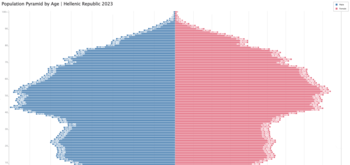
Back Yunanıstan əhalisi Azerbaijani Греция халҡы Bashkir Население на Гърция Bulgarian Demografia de Grècia Catalan Obyvatelstvo Řecka Czech Demograffeg Gwlad Groeg Welsh Δημογραφία της Ελλάδας Greek Demografía de Grecia Spanish Démographie de la Grèce French Demografía de Grecia Galician
| Demographics of Greece | |
|---|---|
 Population pyramid of Greece in 2023 | |
| Population | |
| Density | |
| Growth rate | |
| Birth rate | |
| Death rate | |
| Life expectancy | |
| • male | |
| • female | |
| Fertility rate | |
| Infant mortality rate | |
| Net migration rate | |
| Age structure | |
| 0–14 years | |
| 15–64 years | |
| 65 and over | |
| Sex ratio | |
| Total | 0.96 male(s)/female (2024 est.) |
| At birth | 1.07 male(s)/female |
| Under 15 | 1.06 male(s)/female |
| 15–64 years | 1 male(s)/female |
| 65 and over | 0.8 male(s)/female |
| Nationality | |
| Nationality | Greek |
| Major ethnic | Greek (91.6%)[2] |
| Minor ethnic | |
| Language | |
| Official | Greek |
| Spoken | Languages of Greece |
The Demographics of Greece refer to the demography of the population that inhabits the Greek peninsula. The population of Greece was estimated by the United Nations to be 10,445,365 in 2021 (including displaced refugees).